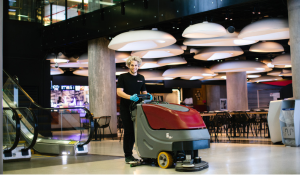By Jessica Brill
With the heightened focus on hygiene and sanitation these last few years, what does commercial cleaning look like post-pandemic? Things have changed and the once almost-invisible teams of people and the tasks they perform are now taking centre stage.
For companies like Impact Cleaning Services, some parts of the job have certainly shifted, but what matters most has stayed the same.
In the beginning
The company began in 1954 under a different name, growing and merging with other companies until 2004, when Chris Boutsalis took over as president and CEO. Today, it’s a family affair, with his son Yiannis Boutsalis as vice president and long-term team member, Lucy Reid, as director of operations.
Starting off by servicing buildings on the ground, Yiannis worked for the company during the summers. Over the last 10 years, he worked his way up the ladder to supervisor, area supervisor, project manager, and is now vice president. Reid, once Yiannis’ supervisor, started at Impact as an account supervisor, working her way up to director of operations, a role she has held for the past 15 years.
“In an industry that’s so male-dominated, Lucy really stands out on her own,” says Boutsalis, calling Reid and her team “the backbone of the operation.” It’s this statement that really speaks to the company’s ethos and why Impact has thrived through the pandemic.
Commercial cleaning and its challenges
Cleaning on this scale is no easy feat. Between staffing, scheduling, and managing scope and scale, it takes a very specific skill set to get the job done.
“No two events are alike,” explains Reid. “Performances, fairs, and shows all have unique and specific needs. Something as simple as confetti in a large arena can have an effect on your operations.”
Not only are there a lot of moving parts, but commercial cleaning companies are put to the test with double-headers, too, when a venue is hosting multiple events on the same day, sometimes with completely different set-ups. Transitioning from a concert to a sporting event could involve adding double crews, following up with deeper post-event cleanings, and rushing to get everything done before the rest of the event set-up happens.
At the time of this interview, Impact was working a stretch of 16 days in a row at the same venue with daily events of all sizes. What’s the best way for a medium-sized company to manage a job of this size? Planning ahead is key. “Our ability to connect with our staff and have very good relationships is what helps us stay nimble and organized,” explains Boutsalis. “Whether it’s a fair for 100,000 people, an event for 20,000 guests, a 5,000-person seated event, or an office building, we make sure the standard is the same, and it’s because we are so hands-on”.
It's this “all-hands-on-deck” mentality in its approach to management that has Impact continuing to grow in this market. “We invest the time and effort to give a better quality of experience and to support our staff as much as we possibly can,” adds Reid.
Cleaning on this scale has always required agility, problem-solving, flexibility, and resourcefulness, but COVID-19 has shone a light on this industry and how they operate.
Cleaning through the pandemic
Most of us have been hyper-aware of cleanliness and hygiene as safety tools during the last few years. With the world looking at disinfection under a microscope, cleaning companies have certainly felt the pressure to manage expectations, handle health and safety for their own employees, and provide a safe and clean workplace for the staff and guests of the venues they serviced.
The commercial cleaning industry was once an out-of-sight-out-of-mind operation for most, without a lot of transparency. Working at night, at off-peak hours, how did companies really know how well their facilities were being cleaned? With the increased need for safety came the heightened expectation that cleaning companies could and would actually deliver on their promises.
For Impact, the added attention did not complicate matters. In fact, it reaffirmed its existing practices. “We had a very high standard already, so that didn’t affect us so much. There was perception and education to address, but we were already performing to the highest standard, with systems in place. We were as ready as we could have been,” Reid says.
It was a lack of consistency that presented the biggest challenge for commercial cleaners like Impact. Opening and closing, stopping and starting, and ever-changing protocols made it difficult to plan ahead and execute with regular efficiency. The evolving landscape also made it tougher to accrue necessary supplies, have enough for everyone who needed them, and manage rising costs for those high-quality products.
“Everyone had different expectations,” explains Boutsalis. “We adapted to every client’s expectations, holding ourselves to the highest standard, using the healthcare requirements as our guide.”
The future of the industry
The pandemic changed the cleaning landscape for good, shifting the public mindset and creating a new level of “normal” when it comes to germs and sanitation. Commercial cleaning companies have had to adjust their scope of work, now focusing on touch points and contact surfaces more than ever.
Hybrid work systems also need to be factored in, as they become more common in all types of workplaces. With more people coming and going with less consistency, and different people crossing paths each day, this presents a new challenge for the cleaning staff.
So much more attention is being placed on cleaning and sanitation, and leaving a venue “looking clean” is no longer enough - there needs to be a cleanliness guarantee for safety.
For many companies like Impact, these adjustments are a way to focus on the process, the products, and the principles. Reid emphasizes that Impact was already committed to managing the risks for its teams and following protocols to deliver the results it promises. “While these practices are new for a lot of our clients, and they’re now looking closely at the processes, they aren’t new to us,” he says.
From challenge, comes innovation
As well as its numerous pain points, the pandemic has also spurred progress within commercial cleaning. The demand for transparency and the desire to minimize exposure have made room for technological advances to streamline processes, track supply consumption, monitor traffic, and more.
Building operators are adopting these tools to better mitigate risk and maximize safety, using that data for visibility and to access building insights while they are off-site.
Following the heightened attention to sanitation protocols, cleaning companies have been able to capitalize on a growing demand for hygiene management. This has certainly been the case for Impact, which recently started up its own hygiene division, offering this much-needed service while already on site to add value, save clients time and money, and help minimize additional traffic in the building.
The future of Impact
Not only has Impact adapted to address the growing needs of its clients, but the company has also identified other ways it can add value for its clients. In 2019, they began operating a few cafeterias. This endeavour ended with the pandemic, but it pivoted, expanding to offering coffee services to offices.
What does coffee have to do with cleaning? Boutsalis explains it is all about the overall client experience. “We were already servicing these clients, so we simply expanded the ways we could help them,” he says. Approaching this vertical with the same ambition as the rest of its business, the Impact team relies on its very strong onboarding process, building relationships, and executing the highest standards wherever its staff goes.
“What makes us different?’ asks Reid. “It’s our people, they are the key to all our success. They make all the difference.”
The commercial cleaning industry landscape looks different today than it did three years ago, with more educated clients, higher standards, and new expectations. The need for transparency and automation will continue, but for companies like Impact, it’s the company culture and the level of service that is the secret to success.
Source:





Leave a Comment